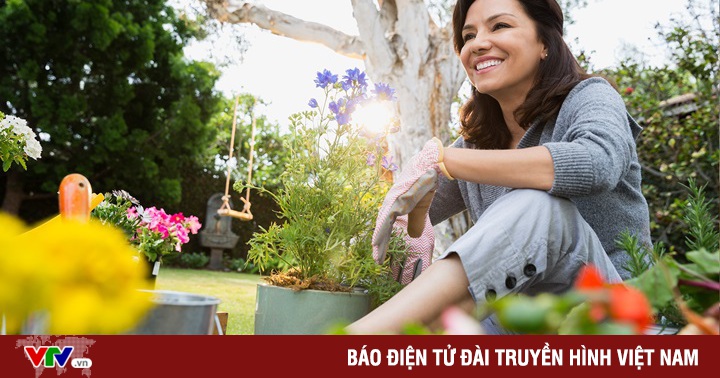Sun protection and heat protection for houses in the summer, especially the western surfaces of the building, need many specific solutions.
Planning solutions
The Vietnamese have long since concluded”Marry a gentle wife to make a house facing the South.. It is a very natural and simple way of planning to minimize the impact of solar radiation on living space. In the summer, the south direction is the direction to catch the cool wind.
However, this rule is only easy to apply to houses in the village-rural structure.
Modern cities depend on many other factors, so they cannot completely choose the direction for themselves construction. This is not to say that the direction is dependent. In all possible conditions, the orientation of the building must be optimized.

Trees on the façade contribute to heat resistance for the building. Image: Ha Thanh
Vietnamese standards on heat protection for housing states: “For houses, try to arrange so that the west-east side of the house has the smallest surface area to limit solar radiation.” As with clusters of works or complex of works, the total ground must be designed reasonably, giving priority to good direction for mainstream works, works with higher heat resistance requirements such as living and working places.
Environmental and ecological solutions
This solution is associated with the planning solution. This is also a solution that our ancestors have applied very thoroughly in traditional architecture. Trees, water surface are always indispensable elements, accompanying the architecture. Trees create shade, prevent and cover architectural surfaces from solar radiation. Water surface (pond, lake, aquarium…) and green trees regulate the microclimate, making the environment cooler and cleaner.
Under the conditions of temperature and humidity difference, the water surface always has the phenomenon of evaporation. Water evaporation is an endothermic process, so it causes the ambient temperature to drop. Trees and water surface are attached to the natural land; All have low emissivity, which are effective factors for overall heat resistance, with a large range of influence.
Architectural solutions
This is considered the broadest and most flexible solution. The architectural solution is the combination of the ground and the building block, the design of a reasonable cover structure to limit the surface exposed to the sun – avoid radiation, or reduce the heat conduction in the material, enhance thermal convection. The basic architectural solutions are as follows:
– Reasonable ground layout, prioritizing main spaces to avoid contact with sun-catching surfaces; push the extra spaces such as stairs, storage, toilet to that side.
– Create setbacks, negative spaces such as halls, loggias, technical slots… to avoid solar radiation entering the main space surface.
– Use a side sunshade structure to be installed outside the covering structure (wall) to reduce radiation and heat conduction. In traditional folk architecture, in many places, there are mats on the porch. This element has been applied a lot in modern architecture with different forms of sunshades, with different types of palanquins.

Using sunshades and flower walls are architectural solutions that bring good performance and aesthetic value. Image: Ha Thanh
– Combination of facades with “rigid structures” to block the sun; attached to the bearing structure and cover. Usually it is the roof, the umbrella, the vertical and horizontal sunshades; and types of walls using flower bricks, walls built for holes.
– Build thick walls, box walls (hollow), use insulation materials (hollow bricks, insulation panels, 3D panels, aerated aggregate concrete…) for the covering structure. The door design is reasonable in terms of location and materials. These solutions are all based on the principle of reducing radiation and conduction of heat from the outside.
– Use all kinds of heat resistant material for roofs such as wicker panels, perforated bricks, corrugated iron roofs (for flat and concrete roofs), use heat-insulated false ceilings (for sloping, tiled roofs). This solution must pay special attention to the problem of ventilation for the air mass between the two roof layers.
– Reduce the emissivity of the surface of the building by plants, such as growing vines on the wall, garden design – water surface on the roof. This is a pretty good aesthetic solution, but there are certain changes over time.
– Organize the premises, design the location and structure the door reasonably; design courtyard, skylight to enhance air convection. The goal is to let the hot air escape up and out, making room for the lower heat mass.
Technical solution
– Air conditioners: Considered modern, and easy to deploy applications. However, air conditioners also have certain disadvantages. First of all, this solution consumes significant energy resources, and affects the environment. According to the principle of thermal balance, to reduce the temperature in the room, it increases the outside temperature by the same amount of heat. Besides, air conditioners are difficult to meet for open spaces, too large spaces.
– Ventilation: Besides natural convection, forced ventilation solution is considered an effective solution to combat heat when natural convection is not effective. Properly designed ventilation systems will contribute to heat resistance, and should be utilized – combined with architectural solutions such as skylights.
– Spraying water, misting: Misting systems have recently been deployed to many applications, in public spaces such as restaurants, and even houses. Spraying water and mist creates the phenomenon of water evaporation, which collects heat, and at the same time enhances air convection. In addition, the pressure of water spray, mist creates cool air movement.
– Use insulating and heat-reflecting glass on sunny surfaces
– Use specialized heat-resistant paint for the surface of the work.
Architect Nguyen Tran Duc Anh
at Blogtuan.info – Source: vnexpress.net – Read the original article here



